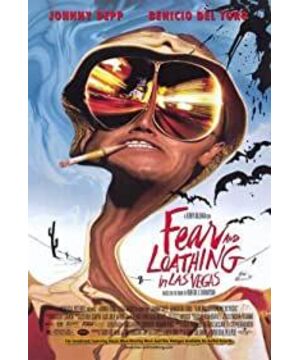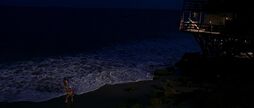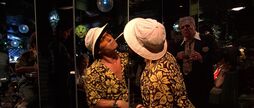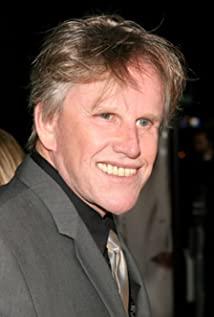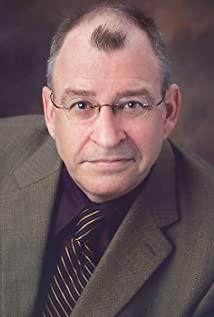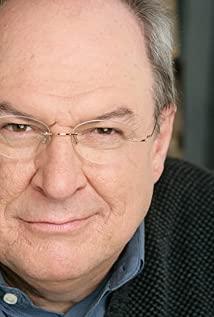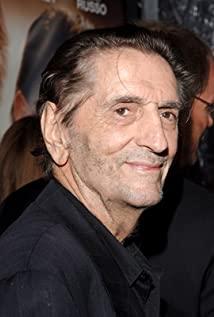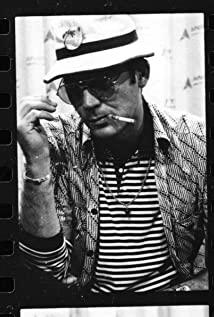In 1998, the same Jonny Depp performed another American dream. Its name was Fear and Loathing in Las Vegas: A Savage Journey into the Heart of the American Dream. This is a nightmare of ecstasy in the sun. From the first second of the film, speeding cars and giant bats that don’t exist can make you feel very high, and then you fall into a nervous excitement for nearly two hours. Although at the end, you still don't particularly understand why you are so high. ——Of course, there is a reason for this.
When the bald reporter played by Jonny Depp, accompanied by a freely mad manner, babbled outside the picture and explained to you two packs of marijuana, 75 mescarine, five pieces of LSD, half a can of cocaine, and a lot of excitement. A pint of tequila, a pint of Rum, a box of Budweiser, a pint of ether and two dozen amyl nitrite inhalants, the film has successfully announced its visual positioning. Accompanied by subjective perspective and first-person narratives, madness, psychedelic, and immensity are accompanied by potential fear, hatred, and confusion, lingering around your eyeballs, ears, corners of your mouth... and even the depths of your brain all the time. The whole movie relishes the bizarre orgasms brought by various hallucinogenic drugs-giggles, hallucinations, crutches, hysterics, vibrant, colorful, and unscrupulous. Whether in his experimental debut "Pi" or in the subsequent detoxification expansion film "Requiem for a Dream", Aronowski also described the reaction after taking drugs, rapid, sharp, abnormal movement of objects, peculiar pain and pain. Breeding of blood; but in FLLV, that kind of temperate lens with a little coldness has disappeared without a trace. There are all kinds of distorted shots and close-ups, and all kinds of illusions for no reason, from the gorgeous and uncast vines. To the ridiculous lizard man meat feast, the bunny running away from the climax of music in the bathtub, to the devil incarnation on the scorched pink bed. The whole film seems to have nothing to do with the American dream-a journalist who is not doing his job properly and a lawyer with a corrupted morality who is respected as a "prototype of God" showed the most informative feelings of drug use in Las Vegas. The road police only showed a little twists and turns when the police seceded.
However, in this savage journey, there is indeed a sense of drifting and anxiety that makes the body and mind nowhere to rest. It is accompanied by crazy tear-jerking comedy scenes, lurking in the narration of reporter Raoul Duke, all the way to the end of the film. You are trying to find the source of these emotions, from the criticized one-line structure and the plotless film. Indeed, compared with Trainspotting, which cannot be ignored, this film lacks elaborate story lines and narrative climaxes. The whole film can be regarded as a synchronous model of sound and picture-Raoul Duke's narration serves as the guide of the plot. And promotion is basically the simultaneous interpretation and annotation of the gorgeous visuals of the film. Montage is used to interpret drug reactions most of the time, and it seems to forget to spend more effort on visual narration and plot guidance.
There is only one exception.
One morning after Hu Tianhudi, Raoul Duke, who was rarely sober, looked out the window of the hotel. It was the 60s that had just passed away. The girls with anti-war marks and flowers on their faces have clear smiling eyes. The hippies who fly high with the age of legal drugs believe that the 60s are in their hands with a light and pure feeling-freedom of speech movement, anti-war Demonstrations. However, when the Going gets Weird, the Weird turn Pro, this rule applies to the angry generation, the beat generation, the ecstatic generation, the E age, the Y age... When those who are awakened from the ignorant youth and the mainstream, are ready to move again Young people who are at a loss as to what to do are frustrated again and again, and suddenly realized that the world is not the warm and light smile after marijuana, returning to the mainstream or self-exile becomes a reality. Raoul Duke and Dr. Gonzo chose the spiritual exile under the mainstream outerwear, with a certain hidden sadness and pain, physical cynicism, and giving back to the society with innocuous small injuries and pains: the film is coming to the end, we see one An innocent girl who was dumped in an unknown direction. Even in real life, you can't believe Christina Ricci's baby face at all; however, on the screen, the pure and confused artistic girl she plays will still arouse your infinite thinking about the possibility of another generation.
The director taught us a lesson here, revealing the hidden truth behind the madness of the film. This is not a purely crazy comedy, nor is it a drug promo, but a nostalgic tragicomedy presented to us by director Terry Gillam based on his favorite work by contemporary crazy writer Hunter S. Thompson. Terry Gillam probably will not forget the experience of being beaten by the police in the 1960s, and has an extreme sense of identity with the contemporary macker, angry youth and idealist Thompson, so he basically adapted the semi-autobiography of the Rolling Stone celebrity verbatim. Compared with his other quirky films, the movie seems to be a little bit stuck on the original-the visual effects are one thing, and the quality of the film is another. However, if you pay a little attention to that era, it’s okay to listen to rock and roll, to scavenge a bit of modern post-modern cultural books, and to understand the difference between marijuana and heroin, compared to watching idols Jonny Depp and Benicio Del Toro, the film itself has twists and turns. What is implicitly expressed by Zhe will probably make people more concerned. Except for the people who have never left the embrace of the system and the ignorant masses, Cannes in 1998 was not when Quentin Tarantino was in charge. There were more or less cults but also the gambling love of various psychedelic drugs. Abomination, of course, will be quickly forgotten.
When Jim Morrison died in 1971, Raoul Duke and Dr. Gonzo happened to behave in Los Vegas. The doors 20 years later echoed with FLLV, showing the mainstream/marginal culture Ukiyo-e of the 1960s. After The doors, Oliver Stone filmed Natural Born Killer again. The young derailed youths who are also careless and worrying about the new era are no longer alien species after the cultural ideals of the entire era were shattered. They are the victims of the next generation of the Cold War. The pain caused by international issues has been passed on to their children by those who have experienced pain and distorted their hearts. They are indifferent, hateful, and have a strong tendency to attack, not comparable to those gonzos in the late 60s and early 70s who only poisoned and indulged themselves in a psychedelic form. And today, in this country where you can open the pornographic website gonzo.com but not gonzo.org, you are even less able to understand what happened in the so-called 60s, and people at that time were thinking and doing. Compared with the era of natural murderers in the 1990s, the so-called Y-generation children will still enter the Weird from theGoing. It's just that they may not be as happy as the Gonzos in the 1960s. Even if they also smile lazily in the smoke of marijuana, they basically don't think about the future of the public. They just tried to escape, distressed, and happy. Gonzo Journalism may quickly fade with Hunter S. Thompson's suicide, just like the FLLV film, which will soon leave only an absurd appearance and a secretive reputation.
"There he goes. One of God's own prototypes. Some kind of high powered mutant never even considered for mass production. Too weird to live, and too rare to die."——Dr. Gonzo is far away from the crowd, Trip is no longer psychedelic , The injury flower is no longer blooming.
View more about Fear and Loathing in Las Vegas reviews


